Interjurisdictional cases of spousal and child support, 2010/2011
Archived Content
Information identified as archived is provided for reference, research or recordkeeping purposes. It is not subject to the Government of Canada Web Standards and has not been altered or updated since it was archived. Please "contact us" to request a format other than those available.
By Chantal Steeves
- General overview of maintenance enforcement
- Analysis of interjurisdictional support order cases
- International cases
- Summary
- Data Sources
- Detailed data tables
- References
- Notes
When the relationship between spouses or partners ends through divorce or separation, or even if no relationship between the parents of a child was ever established, many couples establish an arrangement for continued financial support. According to the 2006 General Social Survey, divorcing or separating couples are much more likely to have support arrangements in place when the couple has children relative to couples with no children.
Support arrangements can be either voluntarily agreed to by the ex-partners or judgment-ordered through the civil court system. According to such agreements or orders, support is provided on a regular, ongoing basis by one of the partners (the payor) to the other partner (the recipient), and beneficiaries may be the children, the recipient, or both (the beneficiaries).
Some support arrangements are registered with maintenance enforcement programs (MEPs). These agencies provide administrative support to payors and recipients of child and spousal support and improve compliance with support payments (Statistics Canada 2002). Registration of a case in a MEP is generally determined by the parties involved in the case, unless the recipient is receiving social assistance or money is owed to the Crown.1 According to the 2006 General Social Survey, 59% of parents who recently divorced or separated (including the dissolution of common-law unions) and who had a child support arrangement registered with a court, had enrolled in a MEP.
This report draws upon results from the 2010/2011 Survey of Maintenance Enforcement Programs (SMEP).2 It includes data from nine reporting jurisdictions that collectively cover 21% of Canada's population (Quebec, Ontario, Manitoba and British Columbia are not included). The article begins with an overview of findings from the survey, including some key characteristics of the cases registered with a MEP. It then focuses on a particularly challenging aspect of maintenance enforcement, which is the enforcement of interjurisdictional support order (ISO) cases, where the recipient and payor live in a different province, territory or country.
Text box 1
Differences among maintenance enforcement programs
Maintenance enforcement programs (MEPs) vary in a number of important aspects because of different local needs and policies. These differences may relate to client profiles, enforcement powers in legislation, enforcement practices, enrolment processes, handling and registration of payments, client responsibilities and case closure. Because of these differences, caution must be used in making comparisons across jurisdictions.
MEPs register cases, process payments, and monitor and enforce cases (Statistics Canada 2002), and the task of processing and ensuring payment of child and spousal support is essentially the same for all MEPs across Canada. However, beyond the processing steps, each jurisdiction has developed its own maintenance enforcement policies and procedures to address local needs.
Among the jurisdictions that report to the Survey of Maintenance Enforcement Programs (SMEP), three have adopted an automatic or "opt-out" registration system: Newfoundland and Labrador, Nova Scotia, and New Brunswick. In these jurisdictions, maintenance orders are automatically enrolled or filed with a maintenance enforcement program at the time of the order. To be removed from the caseload of a MEP, a recipient must request to be withdrawn from the program.
The six other jurisdictions that report to the SMEP, namely, Prince Edward Island, Saskatchewan, Alberta, Yukon, Northwest Territories and Nunavut, have an "opt-in" program, whereby registration is at the option of either the recipient or the payor. The only exceptions are cases where the recipient is entitled to social assistance or money is owed to the Crown by the payor, in which case enrolment in the MEP is mandatory.
Jurisdictions with opt-out registration systems tend to have more cases to administer and enforce since all new court orders are automatically enrolled. Opt-in jurisdictions, on the other hand, tend to have a higher proportion of cases already having arrears when they are first enrolled, or where there has been some difficulty in securing payments.
End of text box 1.
General overview of maintenance enforcement
Women are the recipients of support and men the payors
As of March 31, 2011, there were just under 88,000 cases enrolled in the nine jurisdictions reporting to the SMEP, where the recipient resides in one of the nine jurisdictions.3 For these cases, the payors were almost exclusively men (96%), while recipients were almost exclusively women (96%) (figures exclude New Brunswick). The median ages of payors and recipients were similar (42 and 39 years of age, respectively).4
Almost all beneficiaries of support are children
Maintenance enforcement programs operate primarily for the benefit of children. As of March 31, 2011, children were the only beneficiaries in the vast majority (93%) of the cases where the type of beneficiary was known.5 A spouse was the only beneficiary in another 4% of cases, while both spouse and children were the beneficiaries in 3% of cases.
Among cases with child beneficiaries, almost two-thirds (64%) involved only one child, more than one-quarter (27%) involved two children, and the remainder (8%) involved three or more children.
In total, about 113,000 child beneficiaries of support were enrolled in a MEP in the nine reporting jurisdictions as of March 31, 2011. The median age of the children was 14 years. About 81% of the child beneficiaries were 18 years or under, while the remaining 19% were over 18 years of age.6
Relative to the overall population of children, the proportion enrolled in a MEP varies across reporting jurisdictions (Chart 1). The proportion of children 18 years and under in the nine reporting jurisdictions that were enrolled in a MEP was 6% overall, and ranged from 2% in Nunavut to 9% in New Brunswick.
Chart 1
Proportion of children enrolled in a maintenance enforcement program (MEP) in the nine reporting provinces and territories, as of July 1, 2010
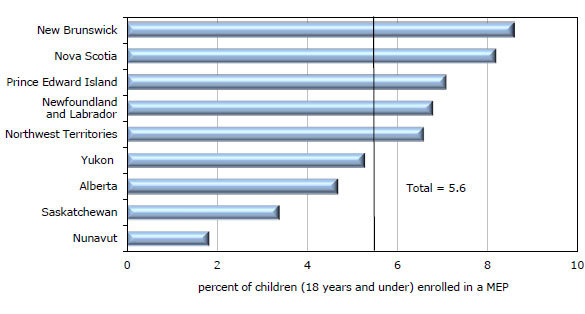
MEP = Maintenance enforcement program
ISO = Interjurisdictional support order
Note: Children enrolled in a MEP includes all children aged 18 years and under enrolled in a non-ISO or ISO-out case and living in the jurisdiction. Quebec, Ontario, Manitoba and British Columbia are excluded from this chart.
Source: Statistics Canada, Survey of Maintenance Enforcement Programs, 2010/2011 and Estimates of Population by Age and Sex for Canada, Provinces and Territories, CANSIM table 051-0001 (accessed November 14, 2011).
Text box 2
Calculation of child support payments
The amount of child support due is often determined using child support guidelines (Department of Justice 2002). The Department of Justice reported in 2001 that 87% of orders were determined using the Federal Child Support Guidelines (FCSG).7 Every jurisdiction across Canada has a provincial/territorial Child Support Guideline for orders authorized under provincial/territorial legislation that closely mirrors the FCSG, with the exception of Quebec which follows its own formula. The guidelines first consider the living arrangements of the child or children. In the large majority of situations, the children live primarily with one parent (General Social Survey 2006). Also considered are the income of the payor, the number of child beneficiaries and the province or territory where the payor lives (to account for differing tax rates across jurisdictions).
End of text box 1.
Median monthly support payment owing was $316
Monthly support payments are determined by taking into consideration a number of factors, including income and jurisdiction of the payor, and number of beneficiaries (see Text box 2). As of March 31, 2011, the median monthly amount of a regular child or spousal support payment8 across the nine jurisdictions was $316. In general, as the number of child beneficiaries increased, so too did the amount of support. Amounts were even higher when the case also involved spousal support. Median monthly amounts due for cases with a single child beneficiary only were lowest in New Brunswick ($200) and highest in Northwest Territories ($412) (Table 1).
MEPs collect most of the total amount due
Over the course of a year, MEPs collect money for payments due and arrears, either directly from the payor or from other sources, including wage garnishments or interceptions of federal payments such as income tax refunds. Payments due are primarily for regular child or spousal support, but may also include event-driven payments, scheduled arrears payments, and penalties. In 2010/2011, over $358 million was collected from payors and other sources in the nine reporting jurisdictions, representing 85% of total payments due.
Most beneficiaries receive a full or partial support payment each month
In addition to looking at collections made over the course of a year, compliance with support obligations can also be analysed on a monthly basis. In an average month in 2010/2011, for the nine reporting jurisdictions, recipients received full payment in almost two-thirds of cases (62%), and partial payment was received in another 8% of cases (Table 2). In an average month just over one-quarter of cases did not receive any support payment (30%).
Just under one-half of cases have arrears equalling more than two monthly payments
When defaults in support payments occur, the case goes into arrears. In the nine jurisdictions, as of March 31, 2011, just under one-half of the cases with a regular support obligation owed arrears (46%), meaning the case had an outstanding balance of more than two times the monthly support obligation.9 Overall, the median amount of arrears owing per case was $4,408.
Cases may not be enrolled in a MEP when payment obligations first begin. If defaults on payments have already occurred, cases can be enrolled with arrears owing. Almost one-half of cases (45%) with arrears enrolled with some arrears already owing (excluding cases where arrears on enrolment are unknown) (figure excludes Prince Edward Island).10
Analysis of interjurisdictional support order cases
When partners separate, either partner may decide to relocate to find a new job or start a new life. If one of the ex-partners relocates to another province, territory or country, two maintenance enforcement programs (MEPs) will become involved in administering and enforcing the support arrangement for the parties. This type of case is known as an interjurisdictional support order (ISO) case. Alternatively, a non-interjurisdictional support order (non-ISO) case involves one MEP and both the payor and recipient typically reside in the same jurisdiction.
ISO cases offer unique challenges for maintenance enforcement programs as MEP legislation and regulations differ across the jurisdictions.11 All Canadian provinces and territories (except Quebec) have passed ISO legislation in an effort to standardize their approach to ISO cases. The court process for transferring cases between jurisdictions is also challenging for MEPs, as enrolment processes and requirements vary. The difficulties arising from these differences may result in enforcement delays and missed payments, especially during the initial enrolment period.
Interjurisdictional support order cases account for nearly one-quarter of total cases
On March 31, 2011, in the nine jurisdictions that report to the Survey of Maintenance Enforcement Programs (SMEP), ISO cases accounted for nearly one-quarter (24%) of total cases enrolled (it should be noted that ISO cases are counted in both jurisdictions that are involved). The proportion of ISO cases ranged from 18% in New Brunswick to 56% in Yukon. Regionally, the highest proportions of ISO cases were found in the territories, while the provinces in the Atlantic region had the lowest proportions (Chart 2).
Chart 2
Proportion of interjurisdictional support order (ISO) cases in maintenance enforcement programs, as of March 31, 2011
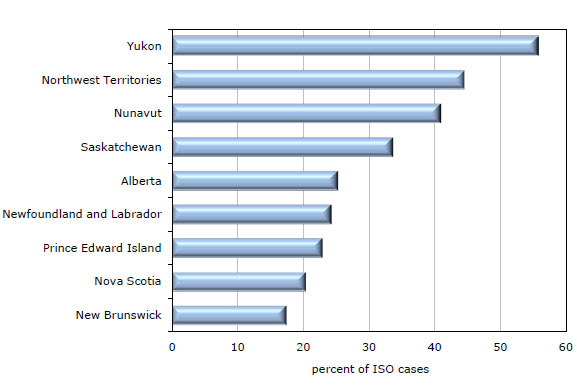
ISO = Interjurisdictional support order
Note: Quebec, Ontario, Manitoba and British Columbia are excluded from this chart.
Source: Statistics Canada, Survey of Maintenance Enforcement Programs, 2010/2011.
Data from the nine jurisdictions that report to the SMEP indicate that large numbers of their ISO cases involve either Ontario or Alberta (Table 3). For example, as of March 31, 2011, for each jurisdiction in the Atlantic region, between 40% and 66% of their ISO caseload was with either Ontario or Alberta.
Proportions of ISO-in and ISO-out cases vary across jurisdictions
Jurisdictions have two types of ISO cases. In "ISO-out" cases the case is registered in the jurisdiction where the recipient lives, and then sent out for enforcement by the jurisdiction where the payor lives. In an ISO-out case, the MEP is responsible for communicating with the recipient and with the enforcing MEP on behalf of the recipient, as well as disbursing money received from the enforcing MEP. "ISO-in" cases come into the jurisdiction for enforcement by the MEP, as the payor lives in the jurisdiction. Thus a jurisdiction can receive a case for enforcement (ISO-in), or send a case for enforcement (ISO-out).
The proportion of ISO-in and ISO-out cases varies widely from one jurisdiction to another (Chart 3). For example, Newfoundland and Labrador has less than half as many ISO-in cases as ISO-out (7% versus 18% of total cases) whereas Alberta has significantly more ISO-in cases than ISO-out (16% versus 10%).
Chart 3
Cases enrolled by interjurisdictional support order status, as of March 31, 2011
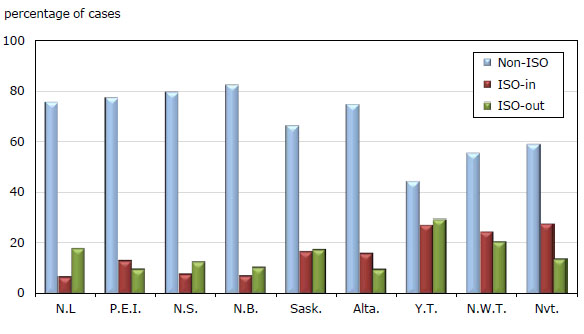
ISO = Interjurisdictional support order
Note: Quebec, Ontario, Manitoba and British Columbia are excluded from this chart.
Source: Statistics Canada, Survey of Maintenance Enforcement Programs, 2010/2011.
Data on ISO cases are collected from both the jurisdiction of the payor and of the recipient.12 In order to avoid double counting, further analysis will use only ISO-in cases, and will draw comparisons between ISO-in and non-ISO cases. The focus of the comparison presented below will be on collections, arrears, and enforcement/tracing activities. Other case characteristics, such as type of beneficiary, number of child support beneficiaries and amount of support due were examined, but are not presented in this report as they are similar for both ISO-in and non-ISO cases.
The collection rate was slightly lower for ISO-in cases than non-ISO cases in most jurisdictions
The collection rate measures the total amount of support payments received by the MEP as a percentage of the total amount due for a specified time period. In 2010/2011, the collection rate for ISO-in cases was slightly less than that for non-ISO cases in each of the reporting jurisdictions with the exception of Yukon and Northwest Territories (Chart 4). Overall, the total payments received represented 80% of the payments due for ISO-in cases compared to 86% for non-ISO cases.
Chart 4
Collection rate by province and territory and interjurisdictional support order status, March 31, 2011
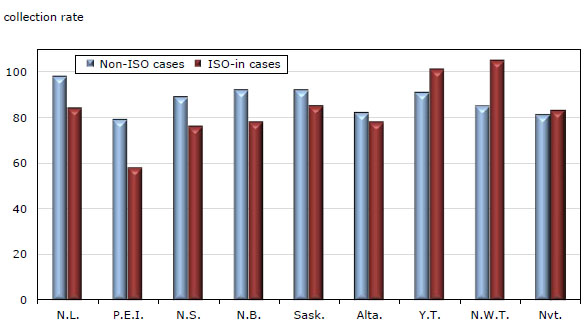
ISO = Interjurisdictional support order
MEP = Maintenance enforcement program
Note: The collection rate is a percentage of the total amounts received by the MEP over the fiscal year, divided by the total amounts due over the same time periods. Some arrears payments received in the fiscal year pay down arrears that accrued before the fiscal year. Quebec, Ontario, Manitoba and British Columbia are excluded from this chart.
Source: Statistics Canada, Survey of Maintenance Enforcement Programs, 2010/2011.
ISO-in cases are more likely to have arrears
A maintenance enforcement case is considered to have arrears if it has an outstanding balance due of two times or more its regular monthly payment. ISO-in cases are generally more likely to have arrears than non-ISO cases. As of March 31, 2011, almost two-thirds of ISO-in cases (64%) owed arrears, compared to less than one-half of non-ISO cases (42%). Furthermore, for cases in arrears, the median amount owing was $8,535 for ISO-in cases, compared to $3,804 for non-ISO cases.
ISO-in cases are more likely than non-ISO cases to be enrolled with arrears already owing to the recipient. More specifically, for cases enrolled as of March 31, 2011 where arrears on enrolment is known, 84% of ISO-in cases had arrears at the time of enrolment, double the proportion of non-ISO cases (44%). One reason for this difference is that ISO-in cases are often transferred from the MEP in another jurisdiction, where they have been enrolled for a length of time and may have already accrued arrears before the transfer. Non-ISO cases tend to enrol soon after the support order is established in court, particularly in opt-out jurisdictions where cases are automatically enrolled.
Proportionally more ISO-in cases receive enforcement or tracing activity than non-ISO cases
If support payments are not forthcoming, MEPs can undertake a variety of actions to enforce current payments or arrears. There are two main categories of enforcement actions: administrative enforcement (for example, wage garnishments, motor vehicle licence interventions) and court enforcement (primarily default hearings). As well, when the payor cannot be located, MEPs undertake tracing activities, such as searching jurisdictional databanks, to locate the payor. Overall, a larger proportion of ISO-in cases (68%) had enforcement or tracing activities during 2010/2011 than did non-ISO cases (53%).13 This was the case in almost all reporting jurisdictions.
International cases
Although they represent a very small proportion (1%) of the overall caseload of maintenance enforcement programs, international support cases, that is, where either the payor or recipient lives outside of Canada, present a number of unique challenges, including: navigating differences in legal and operational systems in various countries, dealing with different exchange rates and banking systems, and undertaking the transfer of funds across international borders.
Canadian provinces and territories have reciprocal arrangements with respect to maintenance enforcement with most U.S. states and a handful of other countries. This system for dealing with international cases has been in place since the 1980s. Currently, federal, provincial and territorial officials are in the process of examining the 2007 Hague Convention on the International Recovery of Child Support and Other Forms of Family Maintenancein view of possible implementation in Canada.
Most international cases are with the United States
About 86% of international ISO cases are with the United States (Chart 5). Child support enforcement is a state responsibility in the United States, and among the Canadian jurisdictions who report to the SMEP, there is at least one case shared with every American state. The United Kingdom (7%), Australia (4%) and other countries (3%) are the reciprocating jurisdictions for the remainder of the international cases.
Chart 5
Proportion of international interjurisdictional support order cases by jurisdiction and whether payor is in or out of Canada, March 31, 2011
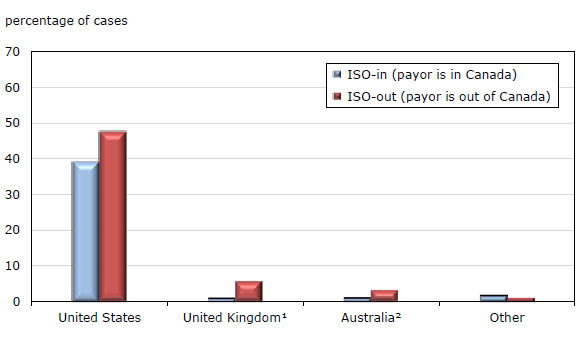
ISO = Interjurisdictional support order
1. The official name of United Kingdom is United Kingdom of Great Britain and Northern Ireland. It includes Scotland, Wales, England and Northern Ireland (excludes Isle of Man, the Channel Islands and British Overseas Territories).
2. Australia refers to the country of Australia (not the continent).
Source: Statistics Canada, Survey of Maintenance Enforcement Programs, 2010/2011.
In 43% of international ISO cases the payor lives in Canada and the MEP in the payor's province or territory enforces payment on behalf of a recipient living outside of Canada. In the remaining 57% of cases, the recipient lives in Canada, and the recipient's MEP communicates with child support agencies in the foreign country where the payor lives, on behalf of the recipient.
Cases involving a payor or recipient living outside of Canada typically have larger amounts due
In 2010/2011, international cases involving either a payor or recipient living outside Canada typically had higher median regular amounts due than domestic cases in which both the payor and recipient resided in Canada. The median monthly payment due in March 2011 for cases with a single child beneficiary was $331 for international cases, compared to $254 for domestic cases.
Cases enforced by Canadian jurisdictions have a higher collection rate
In 2010/2011, the collection rate for international cases enforced by a Canadian jurisdiction (that is, where the payor lives in Canada) was slightly lower than for domestic cases (80% and 85% respectively). For cases enforced by an international jurisdiction (where the payor lives outside of Canada and the recipient lives inside Canada), the collection rate was 63%.
Summary
In the nine reporting jurisdictions (excludes Quebec, Ontario, Manitoba and British Columbia), roughly 88,000 child and spousal support cases were enrolled in a maintenance enforcement program (MEP) as of March 31, 2011. These programs exist primarily for the benefit of children. Almost all recipients of support are women, beneficiaries are children and payors are men. Overall, 6% of children 18 years and younger living in the reporting jurisdictions were enrolled in a MEP. In 2010/2011, MEPs collected about 85% of total payments due, representing just over $358 million.
Cases where the payor and recipient reside in different provinces, territories or countries are known as interjurisdictional support order (ISO) cases, and can be more challenging to enforce. In the jurisdictions reporting to SMEP, the overall proportion of ISO cases was nearly one-quarter. ISO cases tended to have more arrears, slightly lower collection rates and higher proportions of enforcement or tracing activities than non-ISO cases in which the payor and recipient live in the same jurisdiction.
Data sources
Survey of Maintenance Enforcement Programs
The Survey of Maintenance Enforcement Programs (SMEP) is conducted by the Canadian Centre for Justice Statistics at Statistics Canada with funding from Justice Canada. The SMEP gathers microdata on maintenance enforcement cases, including the date of enrolment of the case, age and sex of the recipients and payors of support, payments due and in arrears, processing of payments, and tracing and enforcement actions taken by Maintenance Enforcement Programs (MEPs).
Currently nine provinces and territories report data to the SMEP (Newfoundland and Labrador, Prince Edward Island, Nova Scotia, New Brunswick, Saskatchewan, Alberta, Yukon, Northwest Territories, and Nunavut).
Maintenance Enforcement Survey
The Maintenance Enforcement Survey (MES) is an aggregate survey, meaning that there is no information on individual cases, and data are collected and reported for pre-defined categories. The data collection tables used by the survey were constructed during the identification of information needs and survey specifications in 1995.
Currently, three jurisdictions report data exclusively to the MES: Ontario, Quebec and British Columbia. Jurisdictions that report to the SMEP also provide data to the MES through an interface between the two surveys that is maintained at Statistics Canada.
Data from the SMEP and MES together cover all of Canada except Manitoba.
2006 General Social Survey – Family Transitions (Cycle 20)
In 2006, Statistics Canada conducted the General Social Survey cycle on Family for the 4th time. Previous cycles were conducted in 1990, 1995 and 2001. The target population included people aged 15 or older and living in a private household in one of Canada's 10 provinces. Residents of Yukon, Northwest Territories, and Nunavut, and full-time residents of institutions were excluded. The sample in 2006 was 23,608 people interviewed from June to October. Respondents contacted by the GSS were interviewed by telephone and mainly chosen by a random digit dialling sampling method. The study collected detailed data on various aspects of the family, namely changes experienced by respondents such as separating or getting divorced, child custody, financial support agreement or arrangement for children and ex-spouse/partner. The study also addressed important topics about the family, such as departure from the parental home; marriages of respondent; common-law unions of respondent; fertility and family intentions; birth and adoption; social networks; work-family balance and family functioning; work history and maternity and paternity leave. The response rate in 2006 was 68%.
Detailed data tables
Table 1 Median regular monthly payment due, by type of beneficiary, as of March 31, 2011
References
The World Organization for Cross-Border Co-operation in Civil and Commercial Matters. Convention on the International Recovery of Child Support and Other Forms of Family Maintenance. Concluded on November 23, 2007.
(accessed January 30, 2011).
Department of Justice Canada. 2002. Children Come First: A Report to Parliament Reviewing the Provisions and Operations of the Federal Child Support Guidelines. Vol. 1. Ottawa, Ontario.
Statistics Canada. 2002. Maintenance Enforcement Programs in Canada: Description of Operations, 1999/2000. Statistics Canada Catalogue no. 85-552-X.
(accessed January 30, 2011).
Notes
- Money would be owed to the Crown due to outstanding penalties or because the payor owes subrogated arrears (money that is owed to the government for default that occurred when the recipient was on social assistance and the support payments were assigned to the government).
- The Survey of Maintenance Enforcement Programs is funded by Justice Canada.
- The Maintenance Enforcement Survey collects basic information on MEP cases in Quebec, Ontario and British Columbia. Data from this survey, when combined with the SMEP data, indicate that, excluding Manitoba, there were over 400,000 cases enrolled in a maintenance enforcement program in Canada as of March 31, 2011.
- Most jurisdictions have been reporting to the SMEP for less than five years. The survey results have changed very little over this time period. Therefore, the article focuses on results for the most recent year (2010/2011).
- In certain jurisdictions (Newfoundland and Labrador, Prince Edward Island, New Brunswick, Saskatchewan, Alberta, Yukon and Nunavut) where the case does not have an active regular support obligation, the type of beneficiary is not known. In most instances, these cases no longer have an active support obligation, and remain enrolled to collect on arrears.
- Once a child passes the age of majority (either 18 or 19 depending upon the jurisdiction), he or she does not necessarily stop benefitting from support payments. Support payments can stop at various stages of a child's life, such as when the child reaches the age of majority in his or her jurisdiction, or once the child has completed post-secondary studies, depending upon the terms of the court order or support agreement.
- Information provided in a Department of Justice Publication Children Come First: A Report to Parliament Reviewing the Provisions and Operation of the Federal Child Support Guidelines – Volume 1.
- The amount of child support due is generally calculated using the Child Support Guidelines. Court orders for support made under the Divorce Act usually use the Federal Child Support Guidelines. Some jurisdictions also have similar provincial/territorial Child Support Guidelines for orders authorized under provincial/territorial legislation.
- Just over 20% of cases enrolled on March 31, 2011 did not have a regular payment due in March 2011. About three-quarters of these cases carry arrears. Most (68%) have been enrolled in MEPs since before 2001, and almost one-half (48%) since before 1996. For these cases, the support payment obligations have likely expired but the case remains open to collect on arrears.
- For Newfoundland and Labrador, New Brunswick, Yukon and Northwest Territories, data on arrears on enrolment is unavailable for older cases. These cases have been excluded in the calculation.
- In all provinces and territories, there is provincial legislation that governs the enforcement of interjurisdictional support orders within each jurisdiction. In many jurisdictions the legislation is called Interjurisdictional Support Orders Act. The purpose of ISO legislation is to allow one or both of the parties to obtain or vary a support order under provincial or territorial legislation, or to have an existing order recognized and enforced, when the parties are in different jurisdictions. Quebec has reciprocal agreements with each Canadian province and territory to recognize and enforce each other's court orders for support. Quebec is in the process of passing its own: An Act Respecting the Reciprocal Issue and Enforcement of Support Orders.
- An ISO case will typically have two records in SMEP, one for the enforcing jurisdiction where the payor lives (the ISO-in case) and one for the jurisdiction where the recipient lives (the ISO-out case).
- In some jurisdictions, some actions are not captured electronically so the actions could be underestimated in some instances.
- Date modified:
